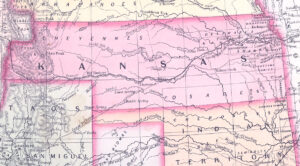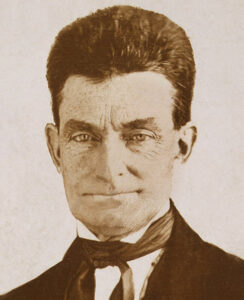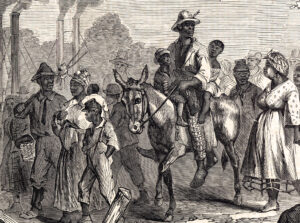
Kansas Territory, 1857. (House Divided Project)
“We have several fugitives on hand, and more are expected,” wrote abolitionist James Montgomery, from Linn County, Kansas in October 1860. “Some of them are from Missouri, and some from Arkansas. When a keen, shrewd fellow comes to us, we send him back for more.” [1]
Montgomery’s casual mention of sending fugitives “back for more,” alluded to the mobility of many enslaved people living in western Missouri. This subject is explored in great detail in Kristen Epps’s recent book, Slavery on the Periphery (2016). While Diane Mutti Burke generally cast Missouri bondage as a distinctive “border south” form of slavery in her study, On Slavery’s Border (2010), Epps focuses specifically on how slavery spanned across both sides of the permeable Kansas-Missouri border. She contends that prior to 1855 the border was porous, almost more of an “invisible boundary” than tangible reality, as slaveholders and slaves moved regularly between the two. Long before the controversial Kansas-Nebraska Act of 1854 and the period of “Bleeding Kansas” riveted the country, slavery already had a strong foothold in Kansas, almost identical to the small-scale bondage prevalent throughout Missouri. She suggests that the intense political struggle surrounding Kansas in the late 1850s was not just about the prospect of slavery in the abstract, but also slavery’s very real and lengthy presence in the territory. [2]
Mutti Burke’s describes mobility within Missouri slave culture, but Epps devotes considerably more time to the concept of enslaved peoples’ mobility, which she argues was “a core feature of slaves’ experiences in the region.” Yet Epps cautions that mobility was not a simple sign of a benevolent system, but frequently was “the result of forces beyond a slave’s personal control,” and that slaveholders regularly “exploited slaves’ mobility for their own ends.” Slaveholders often hired out their slaves during peak seasons, a practice that helped slaveholders increase the efficiency of their work force and remain solvent, while also allowing non-slaveholding whites to reap the benefits of enslaved labor. This “flexibility,” Epps argues, ensured the slave system’s survival and profitability in the border region. [3]
At the same time, slaves could also benefit from increased mobility. Slaves in western Missouri were often tasked with running errands across the border into the Kansas Territory, where they had ample opportunity to make contact with other free or enslaved people and, by the 1850s, a significant number of anti-slavery sympathizers. Additionally, many slaves formed abroad marriages (marriage to an enslaved person from another farm or plantation), and were regularly permitted to visit their spouses, children or other family members who lived on nearby properties. The frequency of “hiring out” also allowed enslaved people vital “access to the landscape,” that was unavailable to many slaves in the Deep South. [4]
That mobility played a crucial role in the 1850s, Epps argues, when enslaved people used their thorough knowledge of the border’s “social and physical geographies,” to plan and organize their escapes. Thus, slave mobility, “the very concession that had made slavery viable out west,” also proved its undoing. By the late 1850s, as free settlers gained the ascendancy in Kansas, the once-fluid border was “redefined” as a dangerous line dividing free Kansas and slaveholding Missouri. Many enslaved people, well-versed in their surroundings, took the opportunity in the years between 1857 and 1861 to escape westward into Kansas. [5]

At the behest of Missouri slave Jim Daniels, abolitionist John Brown led a raid across the Kansas-Missouri border in December 1858, helping to free 11 slaves. (House Divided Project)
Epps does not use the term slave stampede in her book, though her emphasis on slave mobility offers important new insights about the concept. She identifies at least one case that could meet the definition of a slave stampede, highlighting the role of slave mobility. The escape was initiated when a Vernon County, Missouri enslaved man named Jim Daniels crossed the border into Kansas, under the pretense of running an errand. However, Daniels instead made contact with abolitionist John Brown, requesting that Brown help free his family. Brown complied, and on December 20, 1858, entered Vernon County with a force of armed men, freeing Daniels, his family and several other slaves (11 in total), and killing one slaveholder in the process. The group then travelled westward into Kansas and ultimately freedom. While credit has traditionally gone to Brown, in works such as those by Fergus Bordewich, Epps argues that the “raid” was made possible in the first place by Daniels’s mobility, which enabled him to cross the border and arrange the escape. [6]

Freed slaves behind Union lines, 1863. (House Divided Project)
This theme returns in the book’s analysisof wartime escapes in Missouri. While Mutti Burke painted the Union army’s presence in Missouri as an instigator of escapes, Epps minimizes the army’s impact, arguing instead that most escapes happened as slaves seized “sudden opportunities to control their own mobility and obtain their freedom.” She argues that there is “little evidence” indicating African-Americans flocked to Union lines for “liberation,” but rather, they sought out the blue-clad columns for “protection and employment.” Drawing an important contrast to previous scholarship, this follows Epps’s broader reframing of slave resistance as “often proactive, not merely reactive.” [7]
In terms of this project, Slavery on the Periphery adds important detail about the fluidity of Missouri’s western border, as well as drawing attention to the concept of slave mobility and its ramifications. However, in exploring this concept Epps discusses relatively few individual escapes, and does not distinguish large group escapes from individual efforts. While Epps has made a valuable contribution about the role of slave mobility in facilitating escapes, there remains more work to learn how mobility relates to slave stampedes.
[1] James Montgomery to George Luther Stearns, October 6, 1860, in William E. Connelley (ed.), Collections of the Kansas State Historical Society (Topeka, KS: W.B. Smith, 1915), 13:261-262, [WEB].
[2] Kristen Epps, Slavery on the Periphery: The Kansas-Missouri Border in the Antebellum and Civil War Eras (Athens, GA: University of Georgia Press, 2016), 2-5, 85-91.
[3] Epps, 3, 57-58, 63-64, 83-84.
[4] Epps, 72-74, 83-84, 124, 129.
[5] Epps, 105, 115-124, 129, 148.
[6] Epps, 124, 129-132.
[7] Epps, 3, 151, 155; Diane Mutti Burke, On Slavery’s Border: Missouri’s Small-Slaveholding Households, 1815-1865 (Athens, GA: University of Georgia Press, 2010), 283-284.
